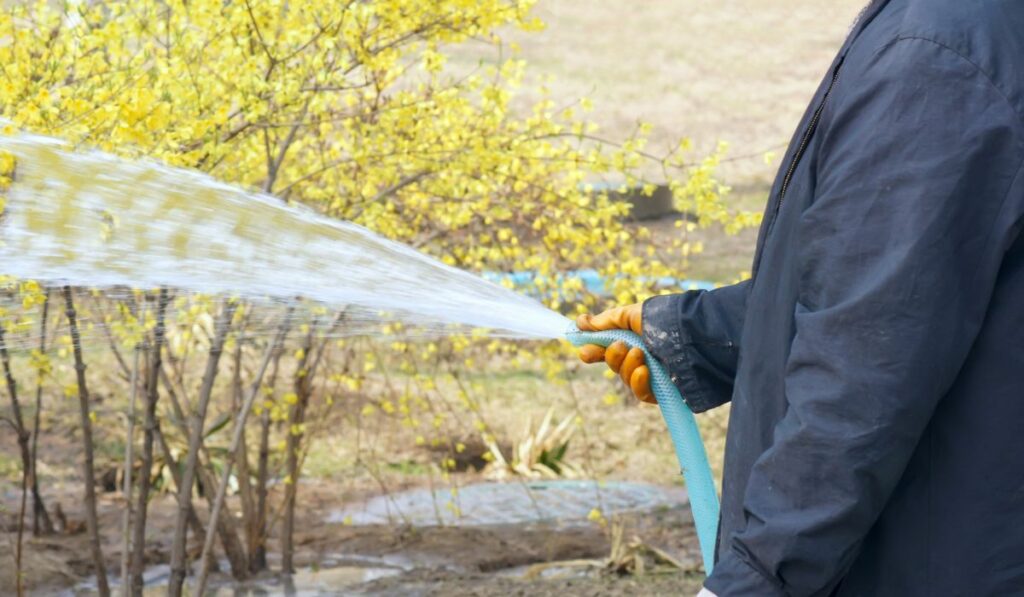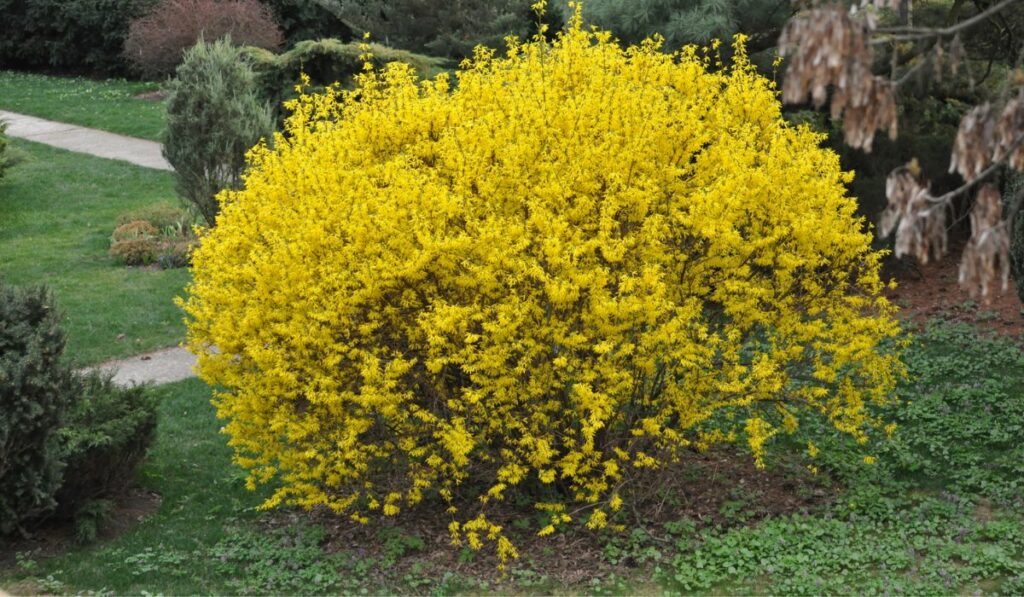With brilliant yellow flowers, Forsythia bushes can add a touch of flair to your yard or garden. These plants are among the first to bloom in spring, creating bare shrubs covered in golden-yellow flower masses. They also produce a fruit that’s used in traditional Chinese medicine. Although propagating forsythia is relatively easy, you’ve got to be careful to water it properly.
Forsythia thrives in well-drained soil but needs regular watering. Ensure forsythia receives at least 1.2 gallons of water weekly until it’s well established. If rain fails to meet this requirement, supplement with water from your garden hose. Once established, forsythia can tolerate drought spells.
Now that you’ve got the general idea, let’s take a closer look at how to keep your forsythia healthy in the long run. We’ll consider how often to water, how to prune, and what sort of lighting conditions are ideal, among other useful tips.
What Is Forsythia?
Also known as the “golden bell,” forsythia is a plant genus in the olive family with approximately ten species of flowering plants. It’s native to East Asia and Europe, but many species are propagated as low-maintenance ornamental shrubs.
Forsythia bushes are deciduous, losing their leaves in the winter. The yellow, four-petaled blooms of certain species bloom along the stems in early spring, even before the leaves. The oppositely arranged leaves along the pithy or hollow stems often have three parts. Forsythia fruits usually resemble a capsule.
How Often Should You Water Forsythia?

Like most shrubs, forsythias need regular, deep watering for the first few years after planting until roots are fully established. Consistent watering is essential, especially during dry periods in spring and summer.
Forsythias are drought-tolerant after they’re well established, eliminating the need for additional watering. But be sure to continue watering during prolonged hot, dry spells. If the leaves on your forsythia look wilted, it may be time to water them. Give your plant a thorough soak once or twice weekly if the weather is dry.
Can You Revive Forsythia?
Yes. Although they start as aesthetic shrubs, forsythias can lose their luster with time. These shrubs need pruning once a year as part of regular maintenance. They may quickly become unmanageable without regular trimming.
Forsythia can become woody and rangy like many other big flowered shrubs. Knowing how to rejuvenate forsythias is crucial if you want to restore their lovely original shape and promote robust blossoming.
How to Prune Forsythia
Shaping a forsythia shrub into a tight, geometric form goes against the plant’s elegant, fireworks-like nature. Whether pruning an overgrown bush or rejuvenating an old plant, follow the steps below annually.
- Cut the outer ring or perimeter by two-thirds using garden pruners (on Amazon).
- Take a third off the height of the remaining branches.
This will stimulate new growth, which will spread in all directions. When pruning, take frequent steps back to assess the overall progress. Trim just above a set of green leaves and angle your cut slightly away from view to conceal the cut.
Rejuvenation Pruning
Rejuvenating a forsythia tree often entails cutting off a third of all branches at the base. Once the shrub has reached maturity, it’s best to rejuvenate and prune it periodically. You’ll get more blooms by cutting back on the oldest branches.
You can also prune the tree by thinning or removing branches crossing one other and those that appear sickly. Thinning promotes the growth of new branches. Thin forsythia in late fall or early spring, just before it blooms.
Forsythias are unique because their flowers appear on stems that developed the previous summer, so they have branches for your floral garden arrangement.
If there are too many new shoots, you should prune them, but keep the healthiest ones. These new branches will take two years year to produce flowers finally. When forsythia looks scraggly, outgrows its space, or has fewer flowers as it ages, it’s time to give it a good hard prune.
Forsythias are ideally hard-pruned in the late fall. This simple method involves cutting all the branches to the ground. A new set of branches will appear next spring. After they’ve filled in, pick out the finest shoots to keep. You’ll have a vibrant young plant with a better bloom at the end of the rejuvenation pruning process.
Hard Pruning Precautions
Remember that hard pruning forsythia shrubs will result in losing one bloom season. Forsythia flowers grow on ancient wood. Rejuvenation pruning may not work if your forsythia is too old or unhealthy. Hard pruning old and sick plants could lead to death. Therefore, there is some risk associated with forsythia rejuvenation pruning.
Consider rejuvenating your forsythia shrub every three to five years.
Tips for Forsythia Care

Robust and easy to grow, forsythia is rarely affected by pests and diseases. But that doesn’t mean it doesn’t need you attention. Here are some valuable tips to help you care for forsythias:
Soil Type
Forsythias flourish in well-drained soils rich in organic matter. However, overwatering or swampy soils have a negative effect.
Mulching and Feeding
In most soils, forsythias require minimal or no regular fertilization. However, feeding after spring pruning might result in vigorous new growth.
Cover the soil with two inches of organic mulch material, such as compost or well-rotted manure. To keep the plant’s stems from decaying, leave a 1- to 2-inch mulch-free space around the base.
Plant Size
With rough gray-brown bark, these plants typically grow to a height of up to 8 feet. Some varieties are taller, while others remain a manageable size. Forsythias spread as wide as their height, so consider planting them in an appropriate location.
Humidity and Temperature
Although forsythias grow best in temperatures between 55 and 75°F, they can tolerate cold or warmer weather. Cold winter below -5°F may prevent the plant from producing flowers in spring.
Forsythia should grow in average humidity. These plants do well in mild, humid settings and perform poorly in high and low humidity. They wilt in excessively dry temperatures and stop flowering in extreme humidity.
Light Requirements
Forsythia shrubs thrive in full sunlight to partial shade environments. Plant forsythias in a location with at least six hours of direct sunlight daily.
Forsythia Propagation
You can propagate forsythia from seeds (on Amazon), stem cuttings, or layering. Seed propagation is the most time-consuming, while stem cuttings and layering are simple techniques.
- Cuttings: Stem cuttings help fill gaps in a forsythia hedge. The resultant plants will be identical to the parent.
- Layering: This method is helpful for shrubs with low-growing or flexible stems. It is straightforward to use and requires very little continuing upkeep.
- Seeds: This is a slower way to grow new forsythia plants, and the offspring may differ slightly from the parent plants.







![How Often Do You Need To Water Sage? [+ Growing Tips] How Often Do You Need To Water Sage? [+ Growing Tips]](https://yourdiybackyard.com/wp-content/uploads/2022/09/Fresh-herbal-sage-in-a-plant-pot-in-the-garden-150x150.jpg)
